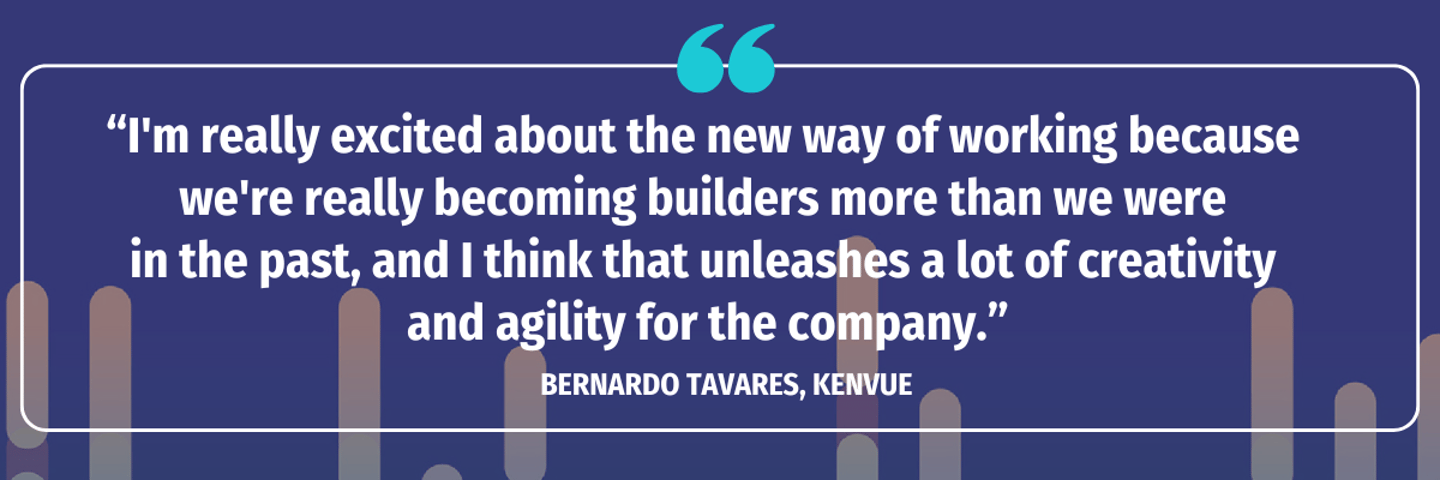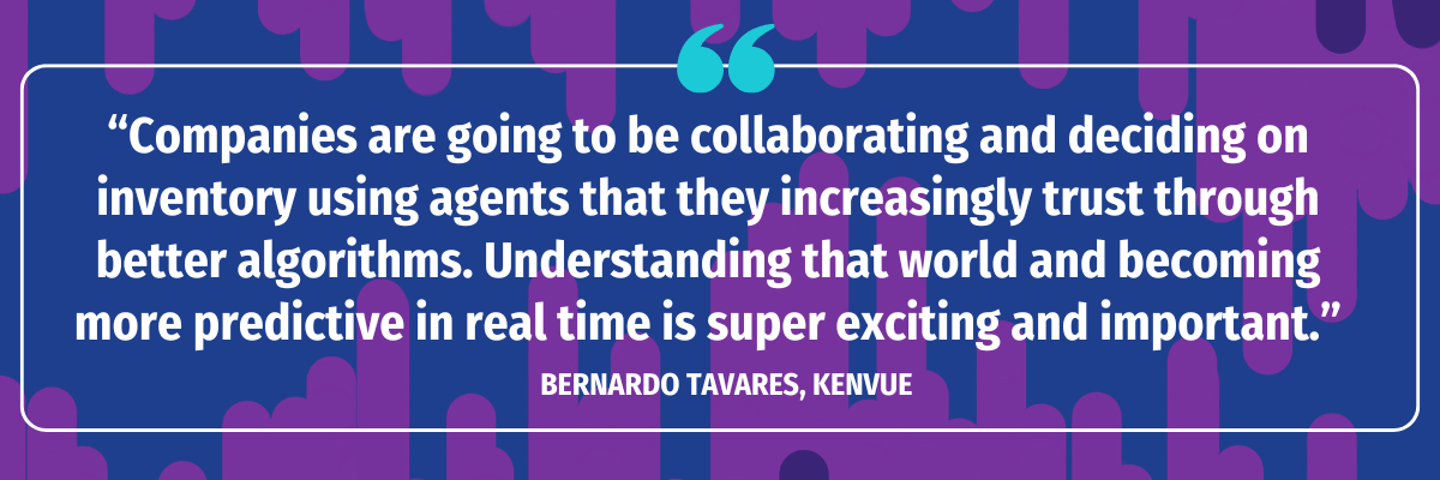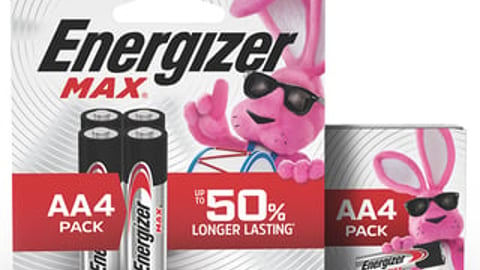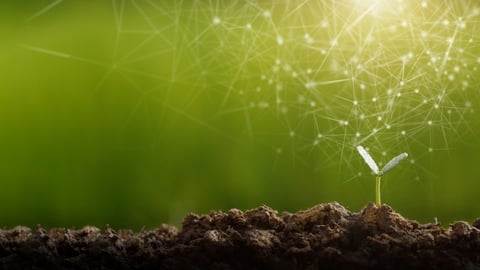How Kenvue’s New Data Framework Is Fueling Sustainability Efforts
It’s been said often enough: garbage in, garbage out. Feed your strategies with unusable data, and don’t be surprised when you end up with a mess.
It’s something Kenvue has taken to heart. But rather than declaring an unwinnable war on dirty data, the CPG pivoted to a more strategic method of employing a data framework and innovation profiler that focuses on asking key questions, developing sustainable business rules, and implementing lots and lots — and lots! — of training.
“You need clean data for a clean world,” Bernardo Tavares, Kenvue chief technology and data officer, tells CGT. Caring about consumers means caring about their digital twins — i.e., the data that represents them — and companies without a firm data quality strategy are set up for a rough road in achieving their sustainability goals.
Data Framework
Kenvue considers sustainability a core component of its Healthy Lives Mission, which it has formalized through about 20 commitments in nine different areas, including plastics, biodiversity, and greenhouse gas emissions.
“We recognize that we can't really have healthy lives without a healthy planet — and without healthy practices as a responsible company,” he notes. “Technology and data have everything to do to support that because you cannot really have a clean, healthy life and planet without healthy data."
In development before Kenvue’s official spinoff from Johnson & Johnson last year, their new data framework hinges upon the firm priority that data should work for employees vs. the other way around. Tavares, who has been with the company for almost 12 years, says it was a significant shift.
“We were doing a lot of data crunching, which is always a laborious job. By putting some of the foundations in place, it was really fortunate for us once the spinoff happened that we were already halfway through that journey,” he says. “That really made the job of the separation much easier because we have a much better handle on our data.”
For one thing, they were spending too much time trying to bring all of their data into one place, which he describes as a “just-in-case, intergalactic data lake.”
“That doesn't work because it's never an end in itself, and that job is never done,” he says. “What we learned was really to pivot in terms of making sure we have the right data just in time.”
Under the new framework, they boil down the data elements needed to answer key questions, such as those for ingredients, materials, and pricing. Data action teams are deployed to create a minimum viable model, which is then hydrated with clean data and followed by sustainable business rules — “to make sure it’s not a fire drill every other year.”
Once their initial data lake was shored up with clean data and the data quality metrics set, Kenvue teams created a data catalog that was democratized and made accessible via APIs.
All of this was solidified with a great deal of training — even more than initially anticipated.
“It can be a dry area,” Tavares notes. “People generally are not accustomed to looking at metadata if they're not experts in data.”
While they initially underestimated the role of training in bringing people along in the journey to become a data-centric company, they made progress in their pivot by latching on to a real business need.
By defining the required data attributes, they were also able to identify overlapping business needs and connect the dots to result in their Product360 and Customer360 data capabilities.
Their sustainable innovation profiler, meanwhile, was developed to aid product development and bring science-based measures to improve environmental performance. This new capability sits at the center of the innovation process within R&D to ensure all those involved — scientists, packaging experts, formulators, etc. — have visibility into how the decisions they make will impact environmental performance.
The ultimate goal is to help associates make product development decisions from both the consumer and environmental points of view.
Cross-Functional Control Tower
To be sure, getting stakeholder buy-in across all levels is a universal challenge within sustainability. To better drive progress, Kenvue has included the Healthy Lives Mission as an OKR in their strategic framework. Not only are all employees’ objectives tied to the strategy, but they have a clearer view of the investments required to achieve the goals and how it links to innovation and drives growth.
A cross-functional governance team has visibility into all tech-enabled investments to ensure they have the right information, funding, and guardrails. Having this control tower of select members of the leadership team has played an important role in keeping the company moving forward, says Tavares.
They meet regularly with the goal of helping initiatives move more quickly, with less friction, and to reduce negative cascading when something is delayed. Beyond aligning, they’ve also done a lot of work to break down strategies into roadmaps and manage interdependencies, which can be especially painful with sustainability initiatives.
“Everything's connected when you try to implement, and sometimes money is not the rate-limiting factor. Sometimes it's capacity or risk.”
The next phase will be to leverage the control tower to ensure interdependencies like ERP upgrades fit in with their program management. The goal is to have investment governance focus on impact and not just output.
For example, each investment is tracked to ensure that once an initiative is live, it has someone responsible to operationally drive an impact out of the capability.
Becoming Builders
When it comes to improving employee experiences — and the role of build vs. buy — Tavares points to the idea of donning an oxygen mask on an airplane before helping others.
“We need to improve ourselves as a function. There's a lot we're doing to modernize our tech and data capabilities, elevating the role of engineering and product management, making sure we're striving to get one-click engineering, automation at scale, and really creating a new way of doing things that is digital first.”
While they previously spent more time managing third parties doing projects for them, they now want to be at the helm and then augment as needed.
“We need core expertise with Kenvue where it matters, and that allows us to be more selective in terms of our partners that are going to be working with us,” says Tavares.
As part of this, they’ve created a global capability center in Bengaluru, which they’re staffing to drive a competitive level of digital capabilities that he says were not previously available in an affordable and innovative way.
“I'm really excited about the new way of working because we're really becoming builders more than we were in the past, and I think that unleashes a lot of creativity and agility for the company.”
What’s Next
Kenvue’s top priority remains accelerating product innovation and omnichannel capabilities, including through the use of generative AI.
“This is really about our growth engine, and to make sure our products are easy to think of and easy to find on the physical shelf or digital shelf. There's a lot of work there in terms of creating capabilities to enable data-driven marketing [and] ensuring our processes within marketing are really consistent.”
Looking ahead, the CPG is doing a lot with graph databases and artificial intelligence to improve ingredient and sourcing traceability, says Tavares. They’re going to continue expanding data attributes for their emissions, and they’ve established an OKR with about 30 data attributes deemed critical to achieving the measurements.
They’re also working with brand teams to create more transparency for consumers on their websites, as well as measuring the impact of data sharing on brand equity.
Tavares says they’re finding success in using generative AI to quickly create content for consumers, and like many CPGs, Kenvue is leaning into consumer insights to better understand what they want to know about product ingredients and subsequent environmental footprint.
They’ve rebuilt their entire marketing tech stack, digital footprint, and websites in support of this. Brands including Neutrogena now include ingredient glossaries on their website, while Johnson’s Baby has a digital transparency tool.
He sees the potential impact of bot-to-bot interactions and consumer use of AI agents to make decisions rather than relying upon online search.
“Companies are going to be collaborating and deciding on inventory and orders using agents that they increasingly trust through better algorithms,” he notes. “Understanding that world and becoming more predictive in real time is super exciting and important.”
To prepare, Kenvue is shifting its focus from business intelligence to increasing responsible use of artificial intelligence and predictive models.
As they spin off from J&J, they’re also focused on leapfrogging their entire enterprise platforms, including their ERP and finance systems, to modernize their infrastructure.
CGT Subscribers Weigh In
Subscribers to CGT’s texting community had the opportunity to share questions with Tavares. Below are his responses, which have been lightly edited and condensed.
How can the industry balance the use of generative AI with the impact that it might have on sustainability efforts?
Tavares: We know that there's a lot of consumption to use all the compute needed to generate these large language models. We see [the tech industry working on this with] different chips or technologies. You see photonics in the future or even the algorithms we use — instead of being exponential, they’re more linear. I think there's a lot that very quickly we're going to see in terms of reduced footprint there.
But I do think we have a duty as customers of the tech companies to inquire about what are you doing about your footprint and how can we make it better? I think it's a job to be done. It requires all of us in the industry to ask questions like this because we can't block that and not address the implications that that might have.
Having said that, I do believe that the benefits of using genAI and AI — in terms of automation and frictionless processes — creates a lot of efficiencies in our plants, our activities, and the way we work. I think there's an upside also in using these things to really reduce our footprint.
It's a balance. If we can have the right metrics to track it, we can ensure that in total that footprint is going down.
What are the customer and consumer inputs you use to help shape your sustainability strategy?
Tavares: From a consumer input point of view, we're always listening to our consumers, and we have been building what we call our Consumer360 data capability to sense consumer needs. We obviously have focus groups and old-school approaches to really talk to our consumers, but we're sensing everything that's going on in social.
We know what they're asking [and] what their aspirations are. A lot of them have to do sustainability, and we can distinguish that by brand [and] geography, but on the whole, they're very consistent. It’s a direct input into our innovation process. We also have AI capabilities to help with driving the next wave of innovation that we're going to be using.
In terms of how we partner with [our retail customers], they have very progressive sustainability practices and mandates, and if you don't subscribe to them, you may not be on the shelf.
But if you're a category leader and you're helping them shape that agenda and drive it forward, then you're really going to become part of the value-creation model with your customers. So winning with customers for us is really important, and sustainability is a tremendous space for doing that as well.
We do that a lot by data sharing. As we sit with customers, we see more of our data scientists coming together from both ends and co-innovating, as opposed to being very protective or guarded about sharing their data. There's more of an open mind of responsibly creating clean rooms and collaborating with our customers, and sustainability is one of the areas that we could partner more.
Looking to stay connected to the consumer goods industry? Sign up for a new kind of insider access with CGT's texting community. Share your opinion, and send your questions right to Lisa Johnston for 1:1 conversations. Texts arrive twice a week. Learn more or sign up below.









